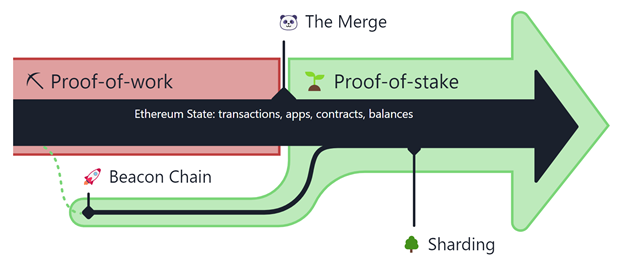
We waited a long time, The Merge was often delayed but finally, The Merge successfully happened. Let’s dive into the events shortly before, during and after The Merge.
💡 If you still don’t know what The Merge is, then click here.
We’ve been talking about The Merge for almost six months now. About how it has been delayed, about what it can lead to. And, most importantly, about how important this event is. And so, on September 15, the long-awaited The Merge finally happened.
It is the transition of the Ethereum blockchain to Proof-of-Stake (PoS) the creator of Ethereum Vitalik Buterin plannedshortly after the launch of Ethereum. The Merge was one of the main points in the long Ethereum roadmap (aka “Eth2”). The goal of Eth2 is to make Ethereum more scalable, more secure and more sustainable.
There was another important stage on the way to The Merge — Beacon chain. This is a fork from the classic Ethereum Proof-of-Work (PoW) network, which brought PoS to Ethereum. Beacon chain evolved in parallel with the main Ethereum network and was created to facilitate The Merge. On September 15, The Merge happened and now, neither PoW nor Beacon chain exists in Ethereum. The crypto giant has completely switched to PoS.

We invite you, dear readers, to plunge into the atmosphere around one of the most important events in the crypto industry. We’ll talk about expectations and how The Merge passed. We’ll also pay attention to the events that occurred in the first days after The Merge.
The sprint to the finish line of The Merge began this spring. It was then that the crypto community had a strong feeling that The Merge would happen soon. This feeling was reinforced by an increase in news from developers about the upcoming The Merge. Then there were delays and the annoying difficulty bomb. We shall not focus on this, because we have already written about it.
A week before The Merge, people were so interested in this event that the number of search queries on Google broke all previous records, as can be seen on the Google Trends chart.

There were so many search queries around the world that Google added countdown clock.

In early September, during the final stages before The Merge took place, a test in the Goerli network which we wroteabout earlier, was successfully passed. In addition, the Bellatrix hard fork was successfully held.
Bellatrix hard fork is the last upgrade of Beacon chain before The Merge. Its purpose was to update and synchronize nodes. Thanks to this update, validators were able to create so-called Beacon Blocks, which were used as a code base. This update allowed The Merge to pass.
Bellatrix hard fork caused a noticeable increase in the price of ETH, but after The Merge, the price of ETH began to fall and continues to fall now. We’ll talk about this later.
Of course, the crypto community had different opinions about The Merge. We also wrote about this earlier. Some people were happy, some people not so much saying that it would be a bad thing, but everyone held their breath in anticipation for the great event.
Those who were not happy with The Merge (mostly miners) paid attention to ETHPoW (aka ETHW), which, according to the assurances of the developers, was supposed to be an alternative to the mining on Ethereum. The price of ETHW was growing rapidly, cryptocurrency trading platforms like FTX and Bybit even launched spot trading with a new token. But, after The Merge, the price of this asset literally collapsed.

Miners also pinned their hopes on another, older alternative to Ethereum, which runs on PoW. The good old Ethereum Classic has become a haven for miners. It did not suffer the sad fate of ETHW, but the price also rose before The Merge and fell after it. The ETC chart is not as depressing as ETHW’s and there are even chances that ETC will grow. The point is most likely that ETC has a much larger capitalization, and its history is much more extensive than that of the new ETHW.

But, on the other hand, the hashrate of Ethereum Classic has grown significantly, which suggests that some miners have directed their computing power to mining ETC.

As for how The Merge went, there were no problems. Everything went smoothly and without glitches, with which the developers congratulated everyone.
Those who care about the environment are also happy to join The Merge. After all, now Ethereum has become energy efficient like never been before. Thanks to The Merge, the carbon footprint of Ethereum will decrease significantly, as Polygon says in a blog post.
“The Merge is estimated to cancel out a whopping 99.91% of Polygon’s network carbon emissions, reducing the annual total to just 56.22 tCO2e. That footprint, a fraction of Polygon’s closest competitors, will make the chain one of the greenest in Web3.”
In addition, due to The Merge, global electricity consumption, according to Ethereum researcher Justin Drake, will decrease by 0.2%.
Before The Merge, someone even managed to mint NFT on the last Ethereum PoW block. This can be seen in the Etherscan data.
Now “The Last POW Block” is placed on the OpenSea platform for 20 ETH.

As for the following events during the first days after The Merge, the price of ETH fell significantly. It is not completely clear what this could be caused by. Maybe the hype has faded and people have started selling ETH, afraid of losing their money. No one knows for sure if there will be further changes in its price.

The Merge has finally happened, and we congratulate the Ethereum developers. It was a long and thorny road. But where this path will lead Ethereum, so far, is not clear. We continue to observe.

